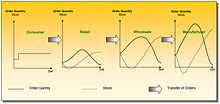Bullwhip effect

The bullwhip effect is an observed phenomenon in forecast-driven distribution channels. It refers to a trend of larger and larger swings in inventory in response to changes in customer demand, as one looks at firms further back in the supply chain for a product. The concept first appeared in Jay Forrester's Industrial Dynamics (1961) and thus it is also known as the Forrester effect. Since the oscillating demand magnification upstream of a supply chain is reminiscent of a cracking whip, it became known as the bullwhip effect.
Causes

Because customer demand is rarely perfectly stable, businesses must forecast demand to properly position inventory and other resources. Forecasts are based on statistics, and they are rarely perfectly accurate. Because forecast errors are given, companies often carry an inventory buffer called "safety stock".
Moving up the supply chain from end-consumer to raw materials supplier, each supply chain participant has greater observed variation in demand and thus greater need for safety stock. In periods of rising demand, down-stream participants increase orders. In periods of falling demand, orders fall or stop, thereby not reducing inventory. The effect is that variations are amplified as one moves upstream in the supply chain (further from the customer). This sequence of events is well simulated by the beer distribution game which was developed by MIT Sloan School of Management in the 1960s.
The causes can further be divided into behavioral and operational causes.
Behavioral causes
- Misuse of base-stock policies
- Misperceptions of feedback and time delays
- Panic ordering reactions after unmet demand
- Perceived risk of other players' bounded rationality
Human factors influencing the behavior in supply chains are largely unexplored. However, studies suggest that people with increased need for safety and security seem to perform worse than risk-takers in a simulated supply chain environment. People with high self-efficacy experience less trouble handling the bullwhip-effect in the supply chain.[1]
Operational causes
- Dependent demand processing
- Forecast errors
- Adjustment of inventory control parameters with each demand observation
- Lead time variability (forecast error during replenishment lead time)
- Lot-sizing/order synchronization
- Consolidation of demands
- Transaction motive
- Quantity discount
- Trade promotion and forward buying
- Anticipation of shortages
- Allocation rule of suppliers
- Shortage gaming
- Lean and JIT style management of inventories and a chase production strategy
Consequences
In addition to greater safety stocks, the described effect can lead to either inefficient production or excessive inventory, as each producer needs to fulfill the demand of its customers in the supply chain. This also leads to a low utilization of the distribution channel.
In spite of having safety stocks there is still the hazard of stock-outs which result in poor customer service and lost sales. In addition to the (financially) hard measurable consequences of poor customer services and the damage to public image and loyalty, an organization has to cope with the ramifications of failed fulfillment which may include contractual penalties. Moreover, repeated hiring and dismissal of employees to manage the demand variability induces further costs due to training and possible lay-offs.
Countermeasures
In theory, the bullwhip effect does not occur if all orders exactly meet the demand of each period. This is consistent with findings of supply chain experts who have recognized that the bullwhip effect is a problem in forecast-driven supply chains, and careful management of the effect is an important goal for supply chain managers. Therefore it is necessary to extend the visibility of customer demand as far as possible.
One way to achieve this is to establish a demand-driven supply chain which reacts to actual customer orders. In manufacturing, this concept is called kanban. This model has been successfully implemented in Wal-Mart's distribution system. Individual Wal-Mart stores transmit point-of-sale (POS) data from the cash register back to corporate headquarters several times a day. This demand information is used to queue shipments from the Wal-Mart distribution center to the store and from the supplier to the Wal-Mart distribution center. The result is near-perfect visibility of customer demand and inventory movement throughout the supply chain. Better information leads to better inventory positioning and lower costs throughout the supply chain.
The concept of "cumulative quantities" is a method that can tackle and even avoid the bull-whip-effect. This method is developed and practised mainly in the German automotive industry, with its expanded supply chains [2] and is established in several EDI-formats between OEM's and their suppliers.
Barriers to the implementation of a demand-driven supply chain include the necessary investment in information technology and the creation of a corporate culture of flexibility and focus on customer demand. Another prerequisite is that all members of a supply chain recognize that they can gain more if they act as a whole which requires trustful collaboration and information sharing.
Methods intended to reduce uncertainty, variability, and lead time:
- Vendor Managed Inventory (VMI)
- Just In Time replenishment (JIT)
- Demand Driven MRP
- Strategic partnership
- Information sharing
- Smooth the flow of products
- Coordinate with retailers to spread deliveries evenly
- Reduce minimum batch sizes
- Smaller and more frequent replenishments
- Eliminate pathological incentives
- Every day low price policy
- Restrict returns and order cancellations
- Order allocation based on past sales instead of current size in case of shortage
See also
- Beer Distribution Game
- Forrester effect mapping
- PID controller
- Supply Chain Management
- Under-damping
References
- ↑ Brauner P., Runge S., Groten M., Schuh M., Ziefle M. (2013). Human Factors in Supply Chain Management. Lecture Notes in Computer Science Volume 8018, 2013, pp 423-432
- ↑ Herlyn W.: The Bullwhip Effect in expanded Supply Chains and the Concept of Cumulative Quantities , epubli Verlag, Berlin, 2014, S. 513-528, ISBN 978-3-8442-9878-9
- Forrester, Jay Wright (1961). Industrial Dynamics. MIT Press.
- Lee, Hau L; Padmanabhan, V. and Whang, Seungjin (1997). "The Bullwhip Effect in Supply Chains". Sloan Management Review 38 (3): 93–102.
- Mason-Jones, Rachel; Towill, Dennis R. (2000). "Coping with Uncertainty: Reducing "Bullwhip" Behaviour in Global Supply Chains". Supply Chain Forum (1): 40–44.
- Bean, Michael (2006). "Bullwhips and Beer: Why Supply Chain Management is so Difficult".
Literature
- Bray, Robert L., and Haim Mendelson. "Information transmission and the bullwhip effect: An empirical investigation." Management Science 58.5 (2012): 860-875.
- Cannella S., and Ciancimino E. (2010). On the bullwhip avoidance phase: supply chain collaboration and order smoothing. International Journal of Production Research, 48 (22), 6739-6776
- Chen, Y. F., Z. Drezner, J. K. Ryan and D. Simchi-Levi (2000), Quantifying the Bullwhip Effect in a Simple Supply Chain: The Impact of Forecasting, Lead Times and Information. Management Science, 46, 436—443.
- Chen, Y. F., J. K. Ryan and D. Simchi-Levi (2000), The Impact of Exponential Smoothing Forecasts on the Bullwhip Effect. Naval Research Logistics, 47, 269—286.
- Chen, Y. F., Z. Drezner, J. K. Ryan and D. Simchi-Levi (1998), The Bullwhip Effect: Managerial Insights on the Impact of Forecasting and Information on Variability in a Supply Chain. Quantitative Models for
- Disney, S.M., and Towill, D.R. (2003). On the bullwhip and inventory variance produced by an ordering policy. Omega, the International Journal of Management Science, 31 (3), 157-167.
- Herlyn, W., "The Bullwhip Effect in expanded Supply Chains and the Concept of Cumulative Quantities", in: Blecker et al. (Eds.): "Innovative Methods in Logistics and Supply Chain Management", p. 513-528, epubli GmbH, Berlin, 2014, ISBN 978-3-8442-9878-9
- Lee, H.L., Padmanabhan, V., and Whang, S. (1997). Information distortion in a supply chain: the bullwhip effect. Management Science, 43 (4), 546-558.
- Lee, H.L. (2010). Taming the bullwhip. Journal of Supply Chain Management 46 (1), pp. 7–7.
- Supply Chain Management, S. Tayur, R. Ganeshan and M. Magazine, eds., Kluwer, pp. 417–439.
- Selwyn, B. (2008) Bringing Social Relations Back In: (re)Conceptualising the 'Bullwhip Effect' in global commodity chains. International Journal of Management Concepts and Philosophy, 3 (2)156-175.
- Tempelmeier, H. (2006). Inventory Management in Supply Networks—Problems, Models, Solutions, Norderstedt:Books on Demand. ISBN 3-8334-5373-7.